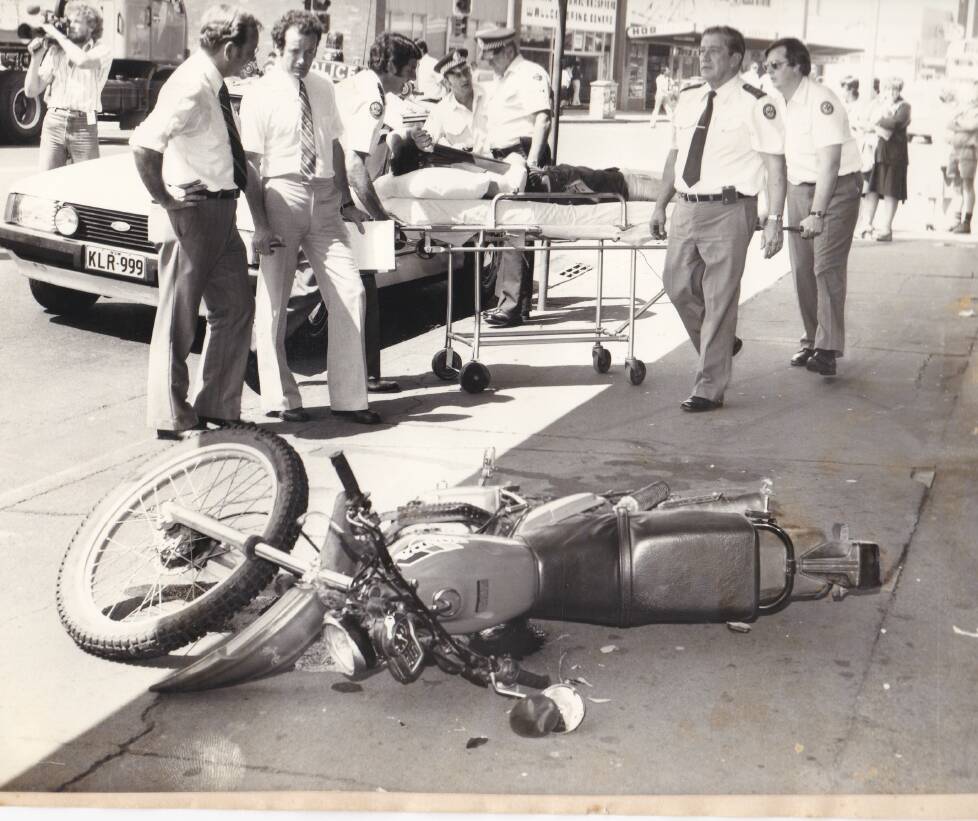
I have written before about two fatal motor vehicle accidents that had an effect on me. This is the most tragic of all and the one which still makes me very angry when I think about its outcome and how the criminal justice system failed those it was designed to serve.
On a warm October day in 1980, shortly after midday, a Newcastle highway patrol officer drove a marked police car westward down Scott Street, Newcastle and, when near the Newcastle Railway Station, saw two motorcycles ahead, stopped and obstructing traffic.
He tooted his horn to indicate for them to move on and when just past Newcomen Street, signalled for them to pull over. They both stopped, the constable stopped just in front of them and as he started to alight from the police car one of the riders accelerated sharply and sped off.
The motorcycle turned into Wolfe Street, at speed, then right into the pedestrian mall (Hunter Street) in a wide arc which took it close to the shops on the corner, then sped through the remainder of the mall, causing pedestrians to scatter, including a young woman who had to pull her two young children out of the path of the motorcycle.
With the police car in pursuit with lights and sirens activated, the motorcycle sped down Hunter Street, reaching speeds of more than 100kmh, weaving in and out of traffic, going onto the incorrect side of the road and at one point narrowly missing an older couple who were crossing Hunter Street in a pedestrian crossing.
When at the intersection of Stewart Avenue, the motorcycle sped through a red light and struck the front of a panel van that was lawfully turning into Stewart Avenue. The rider came off, became airborne and struck a number of pedestrians on the footpath.
The motorcycle mounted the kerb and struck a mother and her eight-year-old daughter, as well several other pedestrians on the footpath including a four-year-old girl and an elderly couple. The eight-year-old girl received horrific, fatal injuries as she was thrust against a plate-glass window. The motorcycle rider suffered minor injuries and was arrested by the highway patrol officer after a struggle.
I interviewed the 18-year-old rider at Newcastle Police Station. He freely admitted to all the actions I have described and said that he was trying to get away because he was unlicensed and the motorcycle was unregistered. Because of the gravity of the matter and his wanton recklessness and total disregard for public safety, a charge of manslaughter of the young girl (plus other appropriate charges) was warranted.
When the matter reached the district court a year later, and despite my strong objections, the crown prosecutor accepted a plea of guilty to culpable driving (maximum penalty five years imprisonment, as against up to life for manslaughter).
The young man's barrister presented a sob story about the impact of the incident on his client. This was before victim impact statements were introduced, so the parents of the child, including the mother who saw her daughter slain and who suffered serious injuries herself (and was unable to attend her daughter's funeral), or any of the other injured and traumatised people, were not able to tell the judge of the impact on them.
The judge then sentenced the young man to 12 months periodic detention, which meant that he would have to report to the weekend detention centre at Tomago each Friday evening and then go back home on Sunday evening. He was still able to work, socialise and live a normal life during the week; his only "punishment" after the carnage he had caused was to lose his liberty on the weekends, for just one year.
During my police career I was involved in many, many court cases, including before judge and jury in district and supreme courts. One of my closest friends was a former senior NSW crown prosecutor and, later, a district court judge. I understand the pressures and isolation felt by judges, knowing that their every word, spoken and written will be scrutinised by lawyers, both defence and prosecution, and may form the grounds for an appeal.
They know that their sentences must comply with statutory sentencing guidelines and should be in line with community expectations. But judges know that prison resources are finite and that imprisonment seldom deters and rarely rehabilitates.
So I have always had the greatest respect for the difficult tasks that judges face every day. In matters that I have been involved with I have generally agreed with, or reluctantly accepted, their decisions.
But this case was different. A young man, unlicensed and riding an unregistered trail bike on Newcastle's busy streets, riding recklessly, at grossly excessive speeds, through the pedestrian mall and almost the full length of Hunter Street before speeding through a red light, hitting a car and killing an eight-year-old girl who was simply walking along the footpath with her mother. A child dead and her mother seriously injured.
Pedestrians and children injured and traumatised. A family suffering unbearable grief. And the child's killer walks away with a slap on the wrist, the mild inconvenience of losing some free time on weekends.
In this case, the judge got it wrong.
- John Ure is a former NSW police detective







